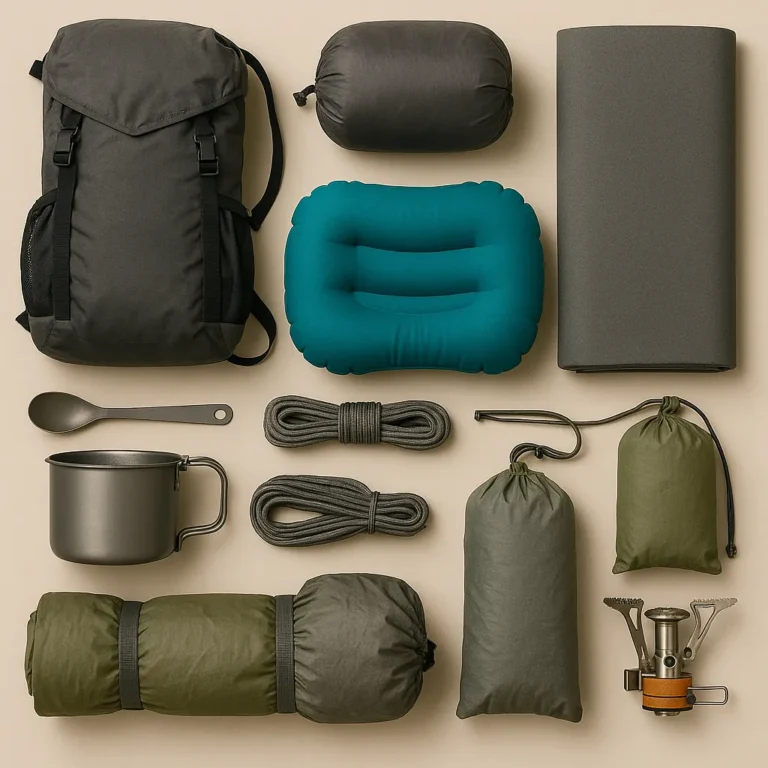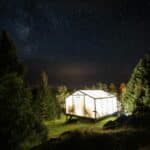Category: Gear | Type: Product Review & Guide | Focus: Ultralight Tent Stakes | Time: 7 m
Last updated: April 2025
Introduction:
For ultralight backpackers, every gram counts — and that includes your tent stakes, which can make or break your setup in challenging conditions. The wrong stakes can bend, pull out, or weigh more than they should — especially in bad weather or poor ground. That’s where ultralight tent stakes come in as essential thru-hiking essentials.
Designed for backpackers who want strength without the steel, these stakes are made from aluminum, titanium, or carbon, and often weigh under 0.5 oz each. Some are minimalist needle stakes, others are Y-shaped anchors, but all are built for fast, secure pitch with minimal pack weight as part of your ultralight backpacking gear system.
“In this guide, we’ve selected the best ultralight tent stakes for backpacking in 2025, tested for real-world holding power, durability, and ease of use — from alpine ridges to desert sand. Some models excel in rocky terrain, while others are better suited for softer soils.
Comparing the Best Ultralight Tent Stakes
| Name | Material | Weight (per stake) | Shape | Best For | Price |
|---|---|---|---|---|---|
| MSR Carbon Core Stakes | Carbon + Alu | 0.19 oz | Needle | Extreme UL setups, firm soil | $$$$ |
| Vargo Titanium Shepherd’s Hook | Titanium | 0.3 oz | Hook | Basic UL anchoring, solo setups | $$ |
| DAC J-Stake UL | Aluminum | 0.39 oz | J-shape | Lightweight + strong hold | $$$ |
| Toaks Titanium V-Stake | Titanium | 0.34 oz | V-shape | Rocky or firm ground | $$$ |
| Zpacks Ultralight Stakes | Carbon Fiber | 0.15 oz | Needle | Tarp systems, mixed conditions | $$$ |
| Nemo Airpin Stake | Aluminum | 0.4 oz | 3-sided (Y-variant) | Windy sites, no cord required | $$$ |

Best Ultralight Tent Stakes: Detailed Reviews
1. MSR Carbon Core Stakes
What It Is:
The MSR Carbon Core is one of the lightest full-strength tent stakes on the market, combining a carbon fiber core with an aluminum sheath. Each stake weighs just 0.19 oz — perfect for ultralight backpackers shaving every gram. These are widely considered among the best ultralight tent stakes for backpacking in rocky terrain 2025 due to their firm-ground performance.
Why It’s Popular Among Backpackers:
Despite the featherweight design, it holds up well in firm soil and grassy campsites, and the aluminum tip adds durability where it’s most needed. The small size makes them ideal for tarps, pyramid shelters, and fastpackers who prioritize minimalist camping gear.
Pros:
- Extremely lightweight — under 0.2 oz per stake
- Carbon fiber stakes = strong with minimal flex
- Aluminum tip resists damage in tough ground
- Packs small and clean
- Surprisingly good holding power for the size
Cons:
- Pricey for a full set
- Not great in soft or sandy soil
- Can be hard to find if dropped — use cord pulls
- Not suitable for hard rocky ground due to difficulty in insertion
Best For:
Ultralight purists and fastpackers looking for maximum weight savings in firm-ground environments.
2. Vargo Titanium Shepherd’s Hook
What It Is:
The Vargo Titanium tent stakes feature a classic ultralight stake design — simple, strong, and time-tested. Weighing just 0.3 oz, these are made from a single piece of Grade 5 titanium, shaped into a slim hook, making them ideal aluminum stakes for backpacking alternatives.
Why It’s Popular Among Backpackers:
It’s a go-to for minimalist setups like tarps and bivvies, and it’s easy to carry extras due to its tiny weight and size. The hook design makes removal easy, even with gloves or frozen fingers. These are particularly good as affordable ultralight tent stakes for solo backpackers.
Pros:
- Inexpensive and ultralight
- Durable titanium resists bending
- Hooked top = easy to extract
- Takes up very little pack space
- Available in bright colors or glow-coated versions
Cons:
- Thin design = poor grip in soft soil
- Easier to rotate or pull out under tension
- Can spin or twist in sandy or rooty terrain
- Can bend under heavy pressure or hammering
Best For:
Backpackers who want light, no-frills stakes for fast-pitch shelters and don’t mind a little tradeoff in holding power.
3. DAC J-Stake UL
What It Is:
The DAC J-Stake UL is a lightweight aluminum stake designed with a slightly curved “J” profile for enhanced grip and rigidity. At 0.35 oz per stake, it balances low weight with impressive holding power tent stakes capability.
Why It’s Popular Among Backpackers:
Used by premium tent manufacturers, DAC stakes are dependable in a wide range of soils — from forest duff to gravelly campsites. The J-shape adds resistance to twisting and pull-out, while the anodized finish improves visibility, making them excellent for how to secure a tarp with ultralight stakes.
Pros:
- Reliable hold in many ground types
- Lightweight yet more durable than many needle stakes
- Slight curve improves retention in tensioned pitches
- Easy to drive with a rock or foot
- Available in bright colors
Cons:
- Not as ultralight as carbon or titanium options
- Slightly bulkier shape
- Can bend in very rocky terrain if forced
Best For:
Backpackers who want dependable holding power with minimal weight, especially for freestanding or semi-freestanding tents.
4. Toaks Titanium V-Stake
What It Is:
The Toaks Titanium V-Stake is a V-shaped tent stake made from tough, ultralight titanium. Each stake weighs 0.34 oz and offers enhanced grip in firm or rocky ground where traditional needle stakes may slip or spin. These are often considered among the top tent stakes for minimalist shelters 2025.
Why It’s Popular Among Backpackers:
The V-profile adds lateral strength and holding power without a significant weight penalty. It’s a favorite among hikers pitching tents in alpine zones or hard-packed dirt, where standard hook stakes fail to hold. Many users find these ideal when comparing titanium vs aluminum tent stakes for ultralight backpacking.
Pros:
- Great grip and resistance to twisting
- Titanium = strong, light, corrosion-proof
- Compact length, but surprisingly effective
- Works well in firm, dry, or stony soils
- Durable under hammering or foot pressure
Cons:
- Can be harder to drive into very soft or loose soil
- No hook or cord loop — can be hard to pull out
- May twist slightly under tension if not seated deep
- Less effective in sandy soil due to reduced grip
Best For:
Backpackers looking for extra holding power in firm ground without giving up ultralight performance. Particularly good for ultralight tent stakes for alpine camping.
5. Zpacks Ultralight Stakes
What It Is:
Zpacks offers a variety of ultralight Carbon Fiber stakes, with their most popular being a 0.15 oz needle-style stake ideal for minimalist shelters and fastpacking setups. Each stake features a sharp point and slim profile for easy ground penetration.
Why It’s Popular Among Backpackers:
Zpacks stakes are purpose-built for UL tarps and tents, especially in firm soil. They’re anodized for visibility and often paired with small pull cords for easier removal — a thoughtful touch appreciated by thru-hikers seeking the best tent stakes for thru-hiking in 2025.
Pros:
- Very lightweight at just 0.15 oz per stake
- Strong Carbon Fiber holds up well for its weight
- Needle shape is easy to insert in most ground
- Available in multi-stake sets for full kits
- Trusted by thru-hikers and UL fanatics
Cons:
- Limited grip in soft or muddy soil
- Small heads can be hard to pull out without loops
- Pricey for Carbon Fiber stakes
- Can snap under heavy impact due to carbon fiber brittleness
Best For:
Backpackers using Zpacks tents or similar UL shelters who want trail-tested, minimal stakes for efficient pitches.
6. Nemo Airpin Stake
What It Is:
The Nemo Airpin is a three-sided aluminum stake with a unique self-tensioning notch that allows you to lock in guylines without using knots or tensioners. At 0.6 oz per stake, it’s not the lightest, but it’s loaded with function.
Why It’s Popular Among Backpackers:
The Airpin’s Y-profile holds extremely well in most soils — even loose ground or light snow. The guylines wrap and lock into the stake itself, which reduces the need for line locks or extra hardware. It’s a favorite among hikers who prefer quick setups and fewer small parts to lose and is perfect when deciding how to choose ultralight tent stakes for windy conditions.
Pros:
- Built-in guyline tensioning system
- Excellent hold in variable conditions
- Easy to use with gloves or cold hands
- Bright finish and shape = hard to lose
- Strong anodized aluminum construction
Cons:
- Heavier than minimalist stakes
- Not as packable (bulkier shape)
- Guyline lock requires specific wrap to hold securely
Best For:
Backpackers who prioritize ease of use and holding power over absolute weight savings — great for exposed or windy campsites.

Which Ultralight Stakes Work Best in Different Conditions
When selecting durable tent stakes for your adventure, consider the terrain:
- Rocky soil: Titanium V-stakes or carbon fiber options provide the best penetration
- Sandy beaches: Wider Y-shaped stakes like the Nemo Airpin offer superior holding power
- Forest floors: J-stakes and shepherd’s hooks work efficiently in rooty, loamy ground
- Alpine conditions: Go for titanium or aluminum with good lateral strength
Looking for more gear recommendations? Check out our Best Lightweight Tarps for Camping Shelters guide for the perfect ultralight shelter to pair with these stakes.
Conclusion
Don’t underestimate the impact of tent stakes in your ultralight kit — they can save weight, secure your shelter, and make tough pitches easier in any terrain. The right ultralight stakes can shave grams, improve pitch security, and reduce frustration in difficult terrain as part of your minimalist camping gear setup.
For pure weight savings, the MSR Carbon Core and Zpacks Ultralight stakes are hard to beat. If you want durability and grip, Toaks V-Stakes and DAC J-Stakes provide dependable performance without bulk. Need versatility or windy-camp confidence? Nemo Airpin stakes deliver smart function with serious holding power.
In the end, it’s all about matching your stake to your ground, shelter, and priorities — and maybe keeping one or two extras in your pack, just in case.
Before you go, check out our guide to How to Pack a Backpack: The Ultimate Guide for Hikers & Campers to learn the best way to store these ultralight stakes and other essential gear.

FAQ
How many tent stakes do I really need?
Most solo shelters require 6 to 8 stakes for full setup. Bring 1-2 extras in case of bending, loss, or tougher ground conditions, and up to 10 for windy setups. Bring 1-2 extras in case of bending, loss, or tougher ground conditions. When using tarp camping stakes, you might need fewer depending on your setup and anchoring methods.
Should you choose titanium or aluminum stakes for your ultralight setup?
Titanium tent stakes are stronger and more durable, especially for hard or rocky ground. However, aluminum stakes for backpacking are lighter and often more affordable. Both work well when matched to the right soil. The titanium vs aluminum tent stakes for ultralight backpacking debate often comes down to your specific needs and budget.
What shape of stake holds best?
- Y- and V-shaped stakes offer excellent grip, especially in wind or soft ground.
- Needle and hook stakes are lighter, but can slip in loose soils.
- J-stakes balance weight and hold well in a variety of conditions.
- Carbon fiber stakes combine lightweight properties with good strength for firm ground.
How to choose ultralight tent stakes for windy conditions?
Opt for Y-shaped stakes like the Nemo Airpin, which excels in windy sites with its self-tensioning notch. Look for wider profiles that resist twisting and stakes with good depth penetration. In exposed areas, consider mixing stake types for optimal security.
Can I use a rock to drive in ultralight stakes?
Yes, but carefully. Titanium and thick aluminum stakes can handle light hammering. Avoid pounding carbon-core or needle stakes — push them in by hand when possible to maintain the integrity of your lightweight hiking equipment.
How do I keep from losing stakes?
Choose stakes with bright anodizing or cord loops. In low light, glow-in-the-dark coatings or reflective tape can help. Always do a final sweep of your camp before packing up.
For more camping essentials, see our Best Odor-Proof Bags for Backpacking guide – another lightweight addition that makes a big difference on the trail.

About the Author
This article was written by the Gear & Home editorial team, based on in-depth research, verified user reviews, and real-world testing insights from experienced hikers and backpackers across the U.S.
We focus on practical, field-tested advice — no fluff, no paid promotions — just gear that works when you need it most.








